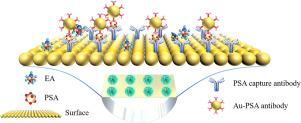Ni(OH)2/MXene-decorated plasmonic interface with dual signal enhancement for sensitive PSA immunoassay in serum
IF 3.7
1区 化学
Q1 CHEMISTRY, ANALYTICAL
引用次数: 0
Abstract
Prostate-specific antigen (PSA) detection is vital for early prostate cancer diagnosis, yet conventional methods suffer from sensitivity and label-dependent limitations. This study presents a surface plasmon resonance (SPR) biosensor enhanced by Ni(OH)/TiCT MXene nanocomposites (NTC) for sensitive detection of total PSA (tPSA) in serum. The NTC architecture synergizes carboxyl-functionalized MXene, amplifying localized electric fields and antibody-binding sites, with Ni(OH) nanoflowers that prevent MXene stacking and enhance refractive index (RI) sensitivity. Optimized via finite element modeling (50-nm Au film, 72.4 ° incident angle), the Au-NTC architecture achieved a 39.34% improvement in RI sensitivity (3064.86 nm/RIU) compared to pristine Au. Through the dual signal amplification mechanism of synergistic enhancement by nanomaterials and sandwich method with gold nanoparticles, enabled detection of tPSA in 20% serum across a wide dynamic range (0.2–160 ng/mL), fully covering the clinical risk threshold (4–10 ng/mL). The platform demonstrated an ultralow limit of detection (LOD) of 0.0361 ng/mL (0.5157 pM) and high specificity against interferons. Kinetic analysis revealed strong antigen–antibody affinity (equilibrium dissociation constant M), while batch-producible sensor chips and integrated microfluidics underscored practical applicability. This work advances label-free SPR biosensing for precision prostate cancer diagnostics, offering significant potential in point-of-care testing and early intervention strategies.


双信号增强的Ni(OH)2/ mxene修饰等离子体界面用于血清PSA敏感免疫分析
前列腺特异性抗原(PSA)检测对于早期前列腺癌诊断至关重要,但传统方法存在敏感性和标签依赖性限制。本研究提出了一种由Ni(OH)22/Ti33C22Txx MXene纳米复合材料(NTC)增强的表面等离子体共振(SPR)生物传感器,用于灵敏检测血清中总PSA (tPSA)。NTC结构与Ni(OH)22纳米花协同羧基功能化的MXene,放大局部电场和抗体结合位点,防止MXene堆积并提高折射率(RI)灵敏度。通过有限元建模优化(50 nm Au膜,72.4°入射角),Au- ntc架构的RI灵敏度(3064.86 nm/RIU)比原始Au提高了39.34%。通过纳米材料协同增强的双重信号放大机制和金纳米颗粒夹心法,实现了20%血清中tPSA在宽动态范围内(0.2 ~ 160 ng/mL)的检测,完全覆盖了临床风险阈值(4 ~ 10 ng/mL)。该平台具有0.0361 ng/mL (0.5157 pM)的超低检出限(LOD)和对干扰素的高特异性。动力学分析显示,抗原抗体亲和力强(平衡解离常数KD=4.26×10−10KD=4.26×10−10 M),而批量生产的传感器芯片和集成微流体强调了实用性。这项工作推进了无标签SPR生物传感用于精确前列腺癌诊断,在即时检测和早期干预策略方面提供了巨大的潜力。
本文章由计算机程序翻译,如有差异,请以英文原文为准。
求助全文
约1分钟内获得全文
求助全文
来源期刊

Sensors and Actuators B: Chemical
工程技术-电化学
CiteScore
14.60
自引率
11.90%
发文量
1776
审稿时长
3.2 months
期刊介绍:
Sensors & Actuators, B: Chemical is an international journal focused on the research and development of chemical transducers. It covers chemical sensors and biosensors, chemical actuators, and analytical microsystems. The journal is interdisciplinary, aiming to publish original works showcasing substantial advancements beyond the current state of the art in these fields, with practical applicability to solving meaningful analytical problems. Review articles are accepted by invitation from an Editor of the journal.
 求助内容:
求助内容: 应助结果提醒方式:
应助结果提醒方式:


